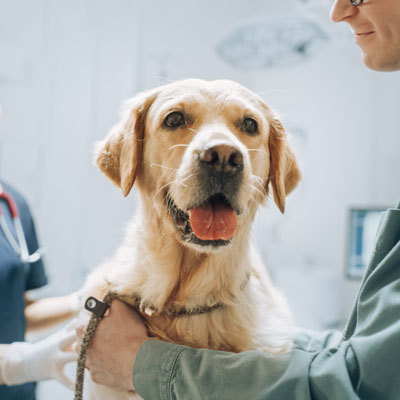Last Updated on April 10, 2024 by Dr. Alisha Barnes

Hip dysplasia is a common condition that affects many dogs, particularly larger breeds. It is a genetic condition that causes improper development of the hip joint, leading to arthritis, pain, lameness, and reduced mobility. While surgery and medications can help manage the symptoms, there are alternative treatments that can provide relief without side effects.
One such approach is pet chiropractic, which focuses on addressing spinal misalignments that affect the nervous system and overall health. At Tails Chiro Care, Dr. Alisha Barnes specializes in hip dysplasia management with chiropractic care. Let’s explore what hip dysplasia is, how it manifests in dogs, and how chiropractic care can help manage the condition.
What is Hip Dysplasia?
Hip dysplasia is a genetic condition in which the hip joint doesn’t develop properly. It can be present at birth but often manifests in young adulthood or later in life. The condition is more common in large breeds, such as German Shepherds, Labrador Retrievers, Great Danes, and Rottweilers, but can affect any breed or mix.
In dogs with hip dysplasia, the anatomy of the hip joint is altered which causes a range of issues. The hip joint comprises the ball (femoral head) and the socket (acetabulum) that should fit together smoothly for optimal movement and function. However, in hip dysplasia, the ball and socket do not fit snugly, causing them to rub and grind against each other.
This abnormal joint structure can lead to progressive wear and eventual arthritis. The cartilage that cushions the joint gets eroded and the dog experiences pain during movement. Other anatomical changes include loss of muscle mass in the hind limbs due to less usage from pain and discomfort, and the development of an abnormal gait or limp. The severity of these changes can vary among individual dogs and different stages of the disease.
What are the symptoms of hip dysplasia?
The symptoms of hip dysplasia can vary in severity and include pain, stiffness, lameness, reluctance to move, difficulty getting up and down, and reduced activity level. Over time, hip dysplasia can lead to arthritis, muscle wasting, and decreased quality of life. While the condition cannot be cured, it can be managed with proper care.
- Pain: Dogs with hip dysplasia often experience pain in the hip area, which may manifest as agitation, restlessness, or vocalization.
- Stiffness: Affected dogs may display stiffness, particularly after periods of rest or inactivity. This stiffness may ease with movement but generally worsens over time.
- Lameness: As the condition progresses, dogs may start limping or favoring one leg over the other. This is especially noticeable when the dog is running or climbing stairs.
- Reluctance to move: Dogs with hip dysplasia may avoid activities that once brought them joy, such as chasing a ball or going for walks. This is due to the discomfort and pain associated with movement.
- Difficulty getting up and down: Standing up or laying down might become increasingly challenging for dogs suffering from this condition due to the pain and stiffness in their hip joints.
- Reduced activity level: Dogs with hip dysplasia may become less active over time, preferring to lie down or sleep rather than engage in physical activity.
- Muscle wasting: Over time, the muscles in the hind limbs can atrophy or weaken due to reduced use.
- Decreased quality of life: Over time, untreated hip dysplasia can lead to a significant decrease in a dog’s quality of life due to chronic pain and loss of mobility.
Traditional treatments for hip dysplasia in dogs include surgery, pain medications, joint supplements, weight management, physical therapy, and assistive devices such as carts, slings, and ramps. While these treatments can be effective, they are not without risks and limitations. Surgery is expensive, invasive, and not always successful, especially in severe cases or older dogs. Medications can have side effects and be costly in the long term. Supplements and weight management require consistent adherence to be effective. Physical therapy and assistive devices can be helpful, but they only address the symptoms, not the underlying cause.
This is where chiropractic care comes in. Pet chiropractic is a non-invasive, drug-free approach to healthcare that focuses on improving joint mobility, nervous system function, and overall well-being. A chiropractor will perform a structural analysis of the spine and joints to identify misalignments, also known as subluxations, that interfere with proper nerve communication and health. By correcting these misalignments through gentle adjustments, a chiropractor can restore proper joint function, reduce inflammation, and increase blood flow to affected areas. This can lead to pain relief, improved mobility, and better overall health.
Chiropractic care can be used in conjunction with traditional treatments for hip dysplasia, such as medications and physical therapy, to enhance their effectiveness and reduce their side effects. Chiropractic adjustments can also be used as a preventive measure for at-risk dogs, such as those with a family history of hip dysplasia or those that are overweight or overactive. Regular chiropractic check-ups can detect and correct subluxations before they cause symptoms, improving the dog’s overall health and reducing the likelihood of developing hip dysplasia.
Treating Hip Dysplasia in Dogs – Boulder, Windsor, and Fort Collins
Hip dysplasia is a common condition that affects many dogs, particularly larger breeds. While traditional treatments such as surgery and medication can be effective, they are not without risks and limitations. Pet chiropractic is a non-invasive, drug-free approach to managing hip dysplasia that can complement traditional treatments or be used as a preventive measure. Chiropractic care focuses on improving joint mobility, nervous system function, and overall well-being, leading to pain relief, improved mobility, and better overall health. If you have a dog with hip dysplasia or are concerned about your dog’s joint health, consider consulting with a pet chiropractor like Dr. Alisha Barnes at Tails Chiro Care to see how chiropractic care can help your furry friend.
